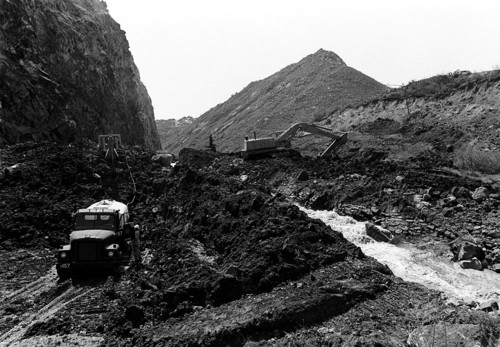This is an archived article that was published on sltrib.com in 2014, and information in the article may be outdated. It is provided only for personal research purposes and may not be reprinted.
After months of heavy snowfall, spring runoff and rain, the drenched hills on the south side of Spanish Fork Canyon morphed into a mudslide with nowhere to go but down toward the small town of Thistle. It was April 12, 1983, a century after the town was built by the Denver & Rio Grande Western Railroad Co.
Traveling two feet per hour and building up enormous pressure, the moving earth pummeled U.S. 6 near its intersection with U.S. 89. The wall of mud twisted tracks and warped roads. By April 17, it accelerated to 4 feet per hour, and spilled onto the narrow canyon floor. It created a 220-foot-high dam blocking the Spanish Fork River and Thistle and Soldier creeks, and a lake 80 feet deep that drowned Thistle.
From the onset, D&RGW railroaders and road crews worked day and night with heavy equipment to repair tracks and the highway, refigure the railway and help save Thistle. They placed drainage pipes inside the mudslide, dredged and hauled muck to prevent the Spanish Fork River from flooding, and tried to channel water. Trucks and crews were dispatched by the Utah Department of Transportation. State, city, county and railroad officials strategized. Highway 6 was closed. Trains and traffic were rerouted. Thistle residents trying to save their homes were warned to evacuate.
According to a November 1983 report in Green Light, a journal published by D&RGW, by April 19, the mudslide was moving as quickly as the water was rising.
"It was impossible to keep any water channel open," the report stated, "and Thistle, once a picturesque railroad town, sleepy and secure, was inundated, gone forever, except for the memories of her former residents and the many railroaders who had passed through."
Surrounded by mountains, the remote Thistle was a much-in-demand crossroad. During its heydays in the early 1900s, it was equipped with such rail necessities as a junction house, round house, engine turntable, depots, water tower, railroad yard, coal chute and a telegrapher who coordinated schedules to avoid mishaps.
Thistle's "helper" engines pushed lengthy loads of railcars up the steep grades to Soldier Summit en route to the coal mines in Carbon and Emery counties. Six passenger trains stopped through while traveling between Salt Lake and Denver. A separate line branched south to Marysvale.
In 1917, Thistle was home to some 600 residents. By 1983, the population dwindled to 50. Many were retired railroad workers, farmers, landowners, businessmen, artists, poets, those desiring independence and space. All were loathe to leave.
In "Thistle: Focus on Disaster," Oneita Burnside Sumsion underscores the personal toil and consequences caused by the Thistle disaster:
The town's oldest resident, Mrs. Vilate Jones, was celebrating her 90th birthday in nearby Birsdeye on April 14 when the mudslide overtook her home.
The Peterson family never finished eating breakfast. Heading to high ground while floodwaters lapped at the foundation of their home, Della Peterson told Sumsion they just held each other and cried.
Madge Haymond, who was baptized in Thistle Creek, filed for flood insurance. She sought a house mover. Finding neither, she watched her home sink up to its windows, discovered her front porch floating about a mile south and realized she could never go home again.
Bob Pace recorded rising water in the newly named Lake Thistle as it overwhelmed groves of trees, fishponds, barns, a granary, chicken coops, corrals and their home before consuming fields and roads.
Two hours before the Dunn family's flood insurance was to take effect, the dam broke. Unleashed waters destroyed their home.
"I was about 18 years old when I heard the road was buckling below Billies Mountain," Springville Public Library cataloger John D. Averett told me recently, "I'm not certain the water ever left. In the 1990s, I started riding up the Thistle landslide on my mountain bike and made it halfway before I felt the mud still moving."
Eileen Hallet Stone may be reached at ehswriter@aol.com. Additional sources: "The Railroad Town of Thistle: Its People, Its Heart" by Luana Henline Baadsgaard and John Edwards. —
Hidden History of Utah
Eileen Hallet Stone's Living History columns for The Salt Lake Tribune have been compiled into a book, "Hidden History of Utah."







